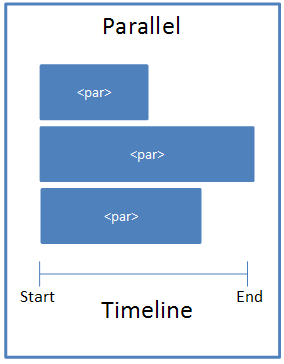<par> (Parallel Time Node)
This element describes the Parallel time node which can be activated along with other parallel time node containers. Conceptually it can be thought of as follows:

[Example: Consider a simple animation with a blind entrance. The <par> element should be used as follows:
<p:timing>
<p:tnLst>
<p:par>
<p:cTn id="1" dur="indefinite" restart="never" nodeType="tmRoot">
<p:childTnLst>
<p:seq concurrent="1" nextAc="seek">
...
</p:seq>
</p:childTnLst>
</p:cTn>
</p:par>
</p:tnLst>
</p:timing>
End Example]
Child Elements |
Subclause |
|---|---|
|
The following XML Schema fragment defines the contents of this element:
<complexType name="CT_TLTimeNodeParallel">
<sequence>
<element name="cTn" type="CT_TLCommonTimeNodeData" minOccurs="1" maxOccurs="1"/>
</sequence>
</complexType>